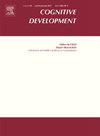Does children's play and associated neural activity differ according to individual differences in social skills, social understanding, and social contexts?
IF 1.8
3区 心理学
Q3 PSYCHOLOGY, DEVELOPMENTAL
引用次数: 0
Abstract
Play is a major part of children’s lives that takes many different forms and presents differently within and between individuals. However, little research has compared how individual differences in children’s play are evidenced in joint play versus solo play contexts, and how these are related to children’s social behaviors and the neural mechanisms underlying these differences. Fifty-seven 4-to-8-year-olds (Mean age: 6.72 years; 93 % White; 52.6 % male) freely played with dolls alone and with an experimenter. Children’s play behavior (pretend vs. set up; doll vs. non-doll toys) and internal state language (ISL) were measured and neuroimaging captured activity in the posterior superior temporal sulcus and dorsolateral prefrontal cortex. Parents reported on children’s social behaviors and theory of mind. We found children engaged in pretend play more and used more ISL in joint play compared to solo play. Both the use of ISL and pretend play were positively related to aspects of their social abilities, but only ISL was found to be associated with neural activity.
儿童的游戏和相关的神经活动是否因社会技能、社会理解和社会环境的个体差异而有所不同?
游戏是儿童生活的重要组成部分,有许多不同的形式,在个人内部和个人之间表现不同。然而,很少有研究比较儿童游戏中的个体差异是如何在联合游戏和单独游戏环境中得到证明的,以及这些差异与儿童的社会行为和这些差异背后的神经机制之间的关系。57名4- 8岁儿童(平均年龄:6.72岁;93% %白人;52.6% %男性)自由地独自或与实验者一起玩洋娃娃。研究人员测量了儿童的游戏行为(假装与设置;玩偶与非玩偶玩具)和内部状态语言(ISL),并通过神经成像捕捉了颞后上沟和背外侧前额叶皮层的活动。父母报告了孩子的社会行为和心理理论。我们发现,与单独玩耍相比,孩子们更多地参与假装游戏,并且在联合玩耍中使用更多的ISL。ISL和假装游戏的使用都与他们的社交能力方面呈正相关,但只有ISL被发现与神经活动有关。
本文章由计算机程序翻译,如有差异,请以英文原文为准。
求助全文
约1分钟内获得全文
求助全文
来源期刊

Cognitive Development
Multiple-
CiteScore
3.20
自引率
5.60%
发文量
114
期刊介绍:
Cognitive Development contains the very best empirical and theoretical work on the development of perception, memory, language, concepts, thinking, problem solving, metacognition, and social cognition. Criteria for acceptance of articles will be: significance of the work to issues of current interest, substance of the argument, and clarity of expression. For purposes of publication in Cognitive Development, moral and social development will be considered part of cognitive development when they are related to the development of knowledge or thought processes.
 求助内容:
求助内容: 应助结果提醒方式:
应助结果提醒方式:


